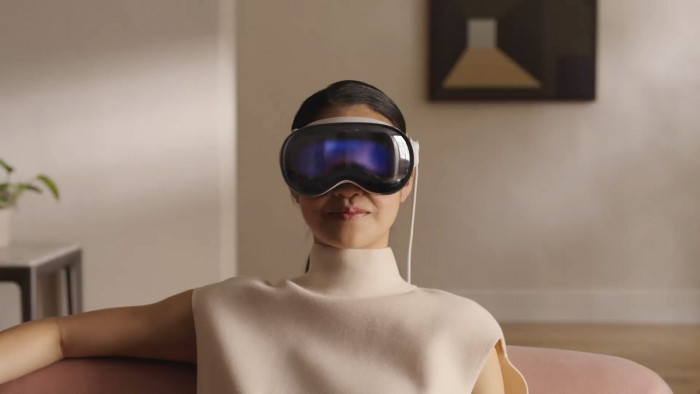Best soundbar 2020: the best TV speakers to upgrade your audio
The best soundbar provides an instant improvement to poor TV sound.


Flat screen TVs may be the most covetable home tech these days, as well as the height of chic, but blade-like sets often sound thin for obvious reasons. The solution? To add an external sound system, typically the best soundbar, to compensate.
There’s no shortage of choice. We’ve spent the best part of 30 hours listening to a varied selection of speakers to upgrade your TV audio, including soundbars, soundbases and active stereo speaker systems, with prices starting at £150.
UPDATED: Shortlist was luck enough to see Panasonic's new TV range recently, including their exciting new soundbar - it comes with its very own wireless subwoofer. The SC-HTB600 supports both Dolby Atmos and DTS:X home cinema audio formats and it's definitely got some serious bass to it. The 16cm speaker actually achieves 200W output. No prices or release dates just yet, but we'll be sure to update you when they come. For now, check out the offerings below.
Any cheapie soundbar will probably be better than the speakers built into a modern telly, but choose wisely and you can get something that sounds a great deal more entertaining.
- Need something portable? Check out our best Bluetooth speaker list
Below you can read what we liked and disliked with all the soundbars we tested but, for clarity, the best soundbar for value we tested was the M2 soundbase. The best soundbar overall was the Sony HT-ZF9.

If you want big beefy TV sound without the frills, the Q Acoustic M2 soundbase offers unbeatable value. Its plinth design will accommodate TVs up to 55 inches, and with an integrated subwoofer there’s no need to find floor space for a separate box. It’s loud and sounds the business for high octane action movies and TV shows. We wouldn’t advocate it for Hi-Fi, but at £299 it’s a stonking performer.

For the best combination of performance and value, we think you can’t currently beat the Sony HT-ZF9. Comprising a slim bar and a separate wireless subwoofer, it features a roster of leading-edge audio technologies and offers state of the art surround sound – you really feel like you’re in the middle of the action. It’s surprisingly musical, too, so when you’re not catching up on Game of Thrones you can get down with your favourite Spotify playlist.
Best soundbar: The Shortlist
best soundbar

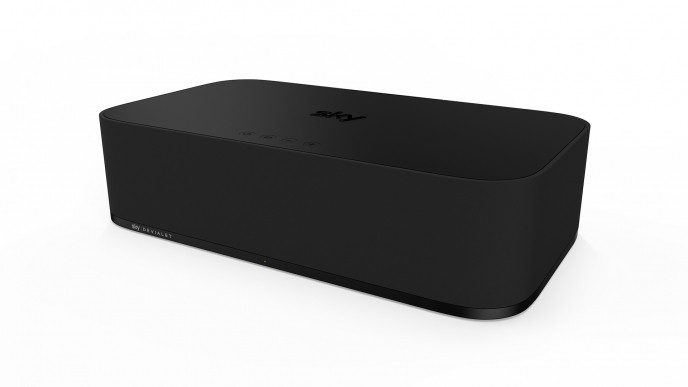
Made by French Hi-Fi specialist Devialet, the Sky Soundbox is designed to partner the Sky Q set-top box. Bluetooth enabled, the Soundbox offers 4k HDMI and a digital optical audio input. Features include next generation EQ, using information from the Sky Q TV box, plus AVL (Automatic Volume Level), a dynamic volume control that negates the differences between loud and quiet TV passages.

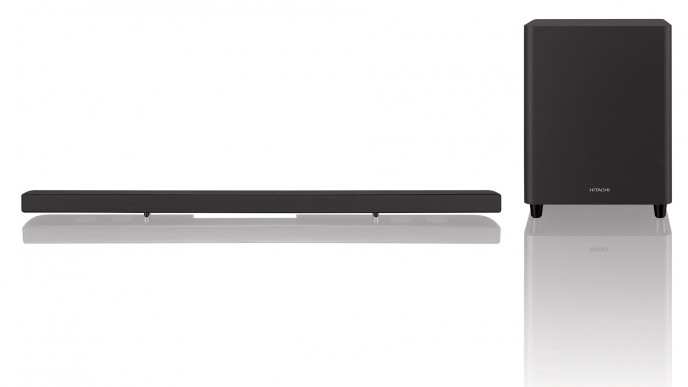
Ultra-slim 2.1 soundbar system aimed at budget buyers. It offers two 4k-capable HDMI inputs, one HDMI with ARC output, two optical and coaxial digital inputs, plus twin aux inputs, and is Bluetooth compatible.

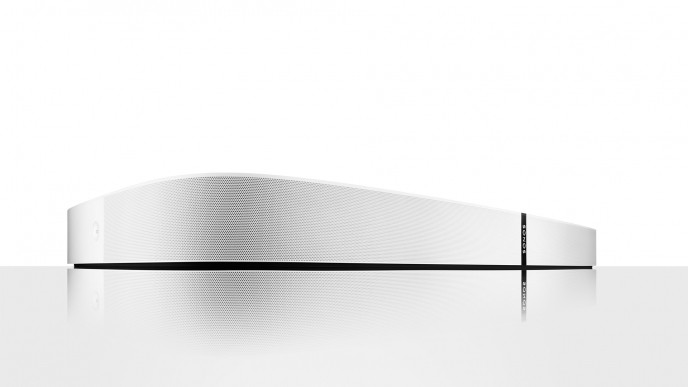
A TV soundbase fully compatible with other Sonos multiroom speakers. Connectivity is limited to a digital optical audio input for the TV. Standard Sonos streaming functionality applies, so you can listen to Tidal, Spotify, Deezer and others on the Playbase and any other Sonos connected speaker you may have around.

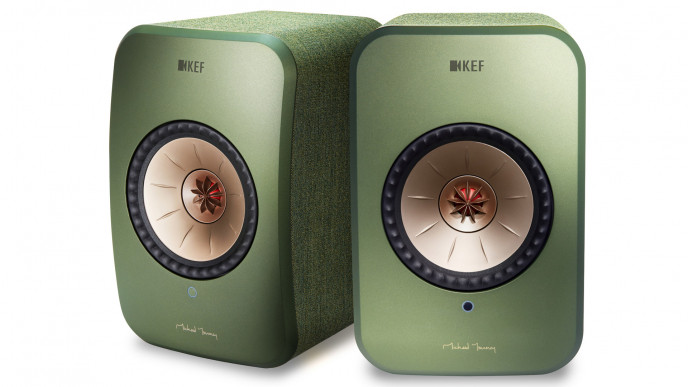
Active wireless stereo speakers sporting an optical digital audio input for TV sound, plus a 35mm jack for an Amazon Echo Dot or Google dongle. High-Res Audio can be delivered either via wired Ethernet or Wi-Fi. Bluetooth aptX and Apple AirPlay 2 are also supported.

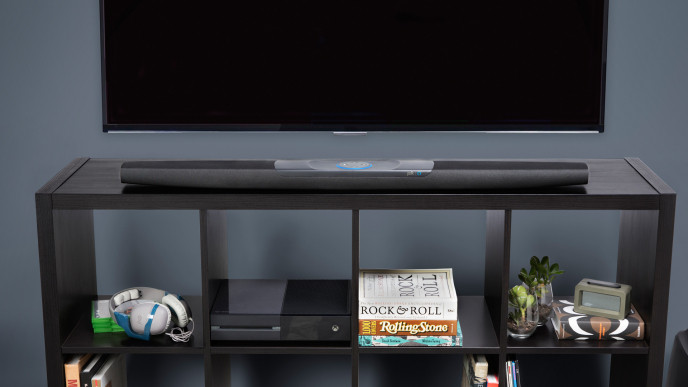
A 2.1 soundbar and wireless subwoofer with fully integrated Amazon Alexa functionality. Connections include two 4k compatible HDMI connections, with ARC, plus an optical digital audio connection, and Polk Voice Adjust – a proprietary dialogue enhancing filter. Wi-Fi and Bluetooth connectivity are standard.

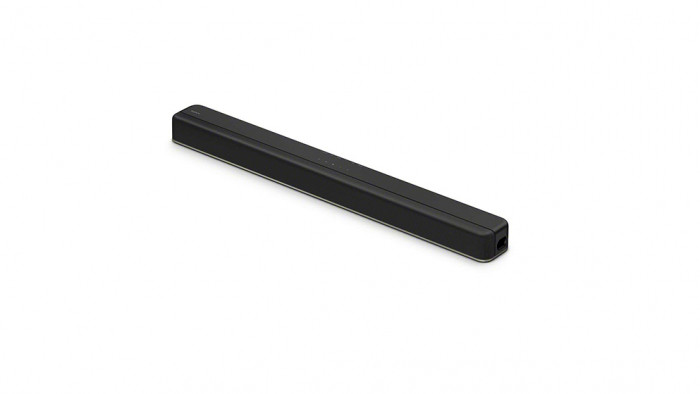
This new, compact soundbar from Sony may have a mid-range price, but it packs an audio punch that means its performance is good enough to rival some of the pricier options on our list. It boasts an integrated subwoofer and it's both Dolby Atmos and DTS:X compatible, which means it's a highly capable soundbar that can deliver truly immersive audio to your front room. It wins in the style stakes too, because it's a neat and nice-looking soundbar that could be at home in, well, any home.

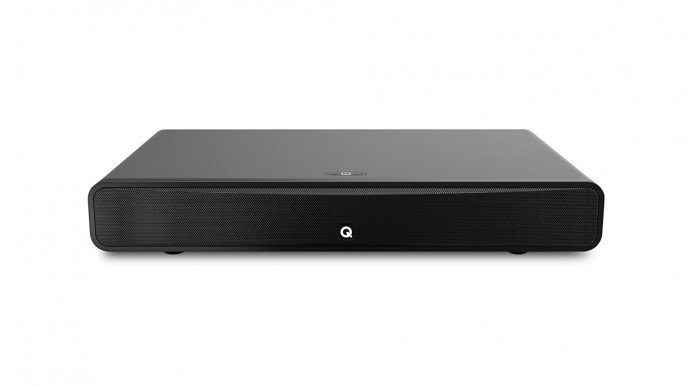
This slim, stereophonic soundbase stands just 98mm tall and has an integrated subwoofer. Connections include a single HDMI with ARC, an optical digital audio input and analogue stereo phonos, plus a 3.5mm minijack. There’s no Wi-Fi or Ethernet on board, but Bluetooth streaming with aptX is supported.

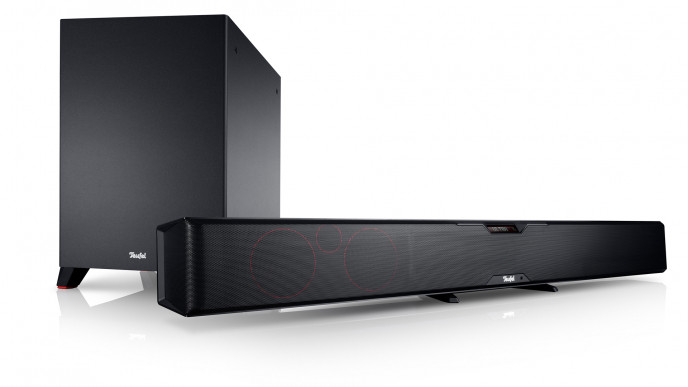
This high-end heavyweight (11kg) stereophonic soundbar and wireless subwoofer features a forward-facing driver array, with two additional side drivers that give audio extra width. Connectivity includes HDMI inputs, all with 4k support, plus HDMI output with ARC. There are also coaxial, optical digital audio and two 3.5mm aux inputs. Wireless functionality extends to Bluetooth and Google Chromecast.

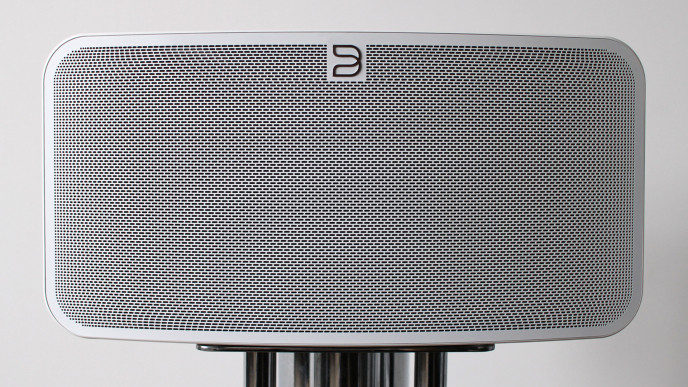
This compact wireless audio system can also function as part of a whole home hi-res-streaming Bluesound wireless sound system (so you can stream TV sound everywhere if you want to) and there’s no subwoofer required.

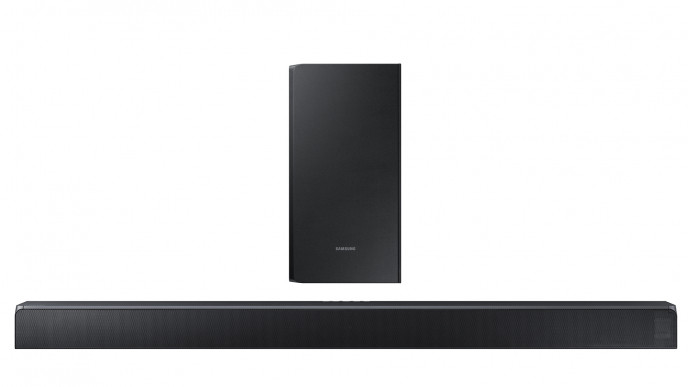
Dolby Atmos and DTS:X compatible soundbar with integrated upfiring speakers and wireless subwoofer with sound tuning by Harmon Kardon. Connections include two HDMI inputs and one output with ARC, plus an optical digital audio input. There’s also support for Samsung’s Bixby voice control platform, plus Bluetooth and Wi-Fi.

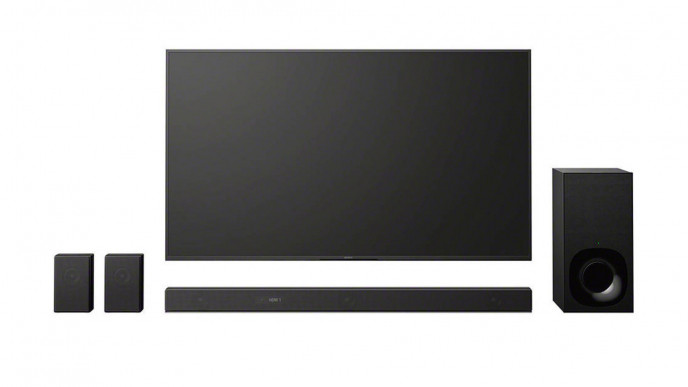
This Dolby Atmos and DTS:X compatible soundbar ships with a wireless subwoofer and sports two 4k compatible HDMI inputs, plus an HDMI out with ARC, analogue stereo 3.5mm minijack and optical digital audio input. In addition to Wi-Fi, Bluetooth and Chromecast are built-in. Key feature is Sony’s Vertical Sound Engine.
The Expert's View
Best soundbars: how we selected
To bar or not to bar? That is the question.
Our selection reflects the wealth of variety available, and the abundance of brands in the game. We have options from familiar TV names (Samsung, Sony, Hitachi and Sky), specialist Hi-Fi outfits (Teufel, Polk, Q Acoustics and KEF), plus lifestyle specialists (Sonos and Bluesound).
While a soundbar may seem the obvious choice if you’re after improved TV sound, it’s not always the best option. It may not look right in your living room, you may not have space for a separate subwoofer, or you may prefer a system with more obvious musical chops.
The Hitachi AXS460BTU soundbar is the cheapest in our group, at just £150. For many it’ll do exactly what they want, but as we discover, it has serious performance caveats.

Far more expensive, the Samsung HW-N850 has no performance shortcomings. It’s an extremely sophisticated soundbar capable of producing convincing wraparound cinema sound. With Dolby Atmos audio from Blu-ray, Sky or BT TV, it offers a dramatic sense of height and power. A big beast, it’s a good match for larger TVs (55-inches and upwards).
But does it really warrant a price premium over the Sony HT-ZF9? Read on...
The Sky Soundbox, available directly from Sky, is built to work with its Sky Q TV box. It is designed by high-end French Hi-Fi company Devialet.
it’s unique in that it’ll automatically tailor its audio performance according to content, so sounds different with movies and sports without you having to worry about the settings at all.
The Polk Command bar is also smart, but in a different way. It boasts fully integrated Amazon Alexa, so no need to add extra accessories to use the popular voice assistant. Instead you can talk directly to the bar, and even plug in an Amazon Fire TV stick and control that by voice, too.
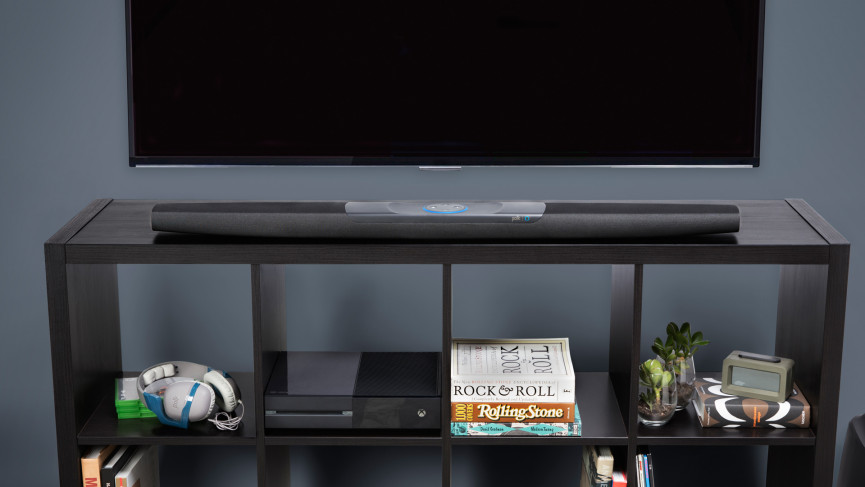
All the soundbars on test come with a separate wireless subwoofer. It’s this that handles mid to deep bass, and allows a soundbar to come across as disproportionately huge. A decent sub will add weight to the footfalls of the Indominus Rex in Jurassic World, make thunder rumble and explosions jolt you from your chair. Soundtracks become immediately more believable.
But if you don’t have room for a soundbar, or just don’t like the look of them, consider a soundbase. These all-in-one units have an integrated subwoofer and act as a platform for your TV. Both the Q Acoustics M2 and Sonos Playbase featured here are soundbase systems.
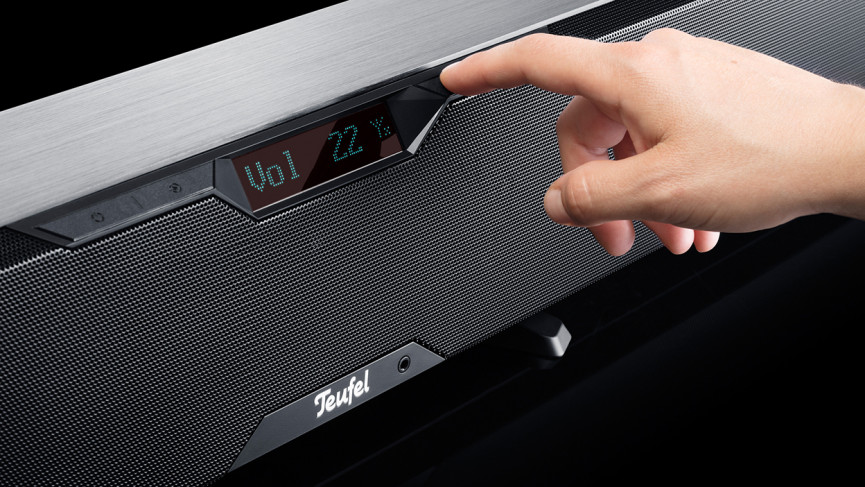
Our final system suggestions are the KEF LSX and Bluesound Pulse Mini 2i. Neither soundbar nor soundbase, these are lifestyle audio systems that just happen to do a cracking job with TV audio.
The KEF LSX speakers should sit either side of your screen. The Bluesound Pulse Mini 2i is a funky all-in-one system that would typically go on a shelf below the TV. Both function as high quality stereo speakers for streamed audio from your smartphone, and as impressive TV audio solutions.
We also considered connectivity. Most soundbars and soundbases connect to a TV using a HDMI with ARC (Audio Return Channel) connection. Look for the HDMI ARC label on your TV’s inputs, because only one will be compatible. HDMI with ARC allows two-way communication between your TV and anything plugged into it, so any sound will automatically come from the soundbar.
If your TV doesn’t have HDMI with ARC, use its optical digital audio output instead. Active stereo speakers also use this optical audio connection, as they normally lack a HDMI connection.
Best soundbars: how we tested
To put these sound systems through their paces, we chomped our way through countless bags of popcorn, watching movies on Blu-ray known for their spectacular soundtracks, and binging on shows from catch-up and streaming services. We also put the speakers through their paces musically, with a healthy mix of flouncy Hi-Fi demo stuff and hard hitting rock and reggae.
The objective was to find out just how large they could sound. Did they make films feel cinematic? Does the audio appear to escape the confines of the screen? Basically, did they make us grin and tap our toes?
Scenes we’ve now watched far too many times include the climax of Batman V Superman: Dawn of Justice, wherein Superman, Batman and Wonder Woman square off against Doomsday (great to assess dynamics, low frequency effects and sheer sonic scale), and the opening to Mad Max: Fury Road – listen out for the spatial positioning of the ‘Where are you, Max?’ whispers, and the arrival of the chasing pack – do their vehicles roar into view from the side or over your head?
When it comes to TV, the series finale of Sky Atlantic’s period epic Britannia, is a fine tester, too. The forest scenes are alive with detail and crows caw from the side. The altogether different Titans (Netflix) has an excellent, multi-layered soundmix, full of fine detail and dynamic action.

We tried Dolby Atmos audio with those systems that support it. Dolby Atmos is the latest in surround sound technology. Often referred to as 3D audio, it doesn’t just surround you with sound, it has the ability to place audio above your head, too, which can be exceptionally cool. Both the Samsung HW-N850 and Sony HT-ZF9 are Dolby Atmos compatible, so we wanted to find out how immersive they are.
The Sky Soundbox was used exclusively with a Sky Q box. That’s because the relationship between content and device is unique. Select Q Sound during a Sky sports broadcast and the soundstage opens up, giving a better sense of it being live.
The Soundbox uses Dynamic Volume control, which equalises speech with music and effects. We discovered that while dialogue was crisp and clear, the Soundbox wasn’t particularly exciting – gunshots and explosions are as loud as chit chat and doors closing.
Interestingly, the most filmic of all our TV sound systems tested wasn’t a Dolby Atmos model, but the Teufel Cinebar Pro. This trades clever audio processing for Hi-Fi quality speaker drivers and masses of amplification. It’s a big system – and sounds even bigger. The subwoofer in particular makes that Batman V Superman sequence sound positively epic. You can feel the weight in Superman’s punches, and when Wonder Woman’s theme kicks in, we get goosebumps.
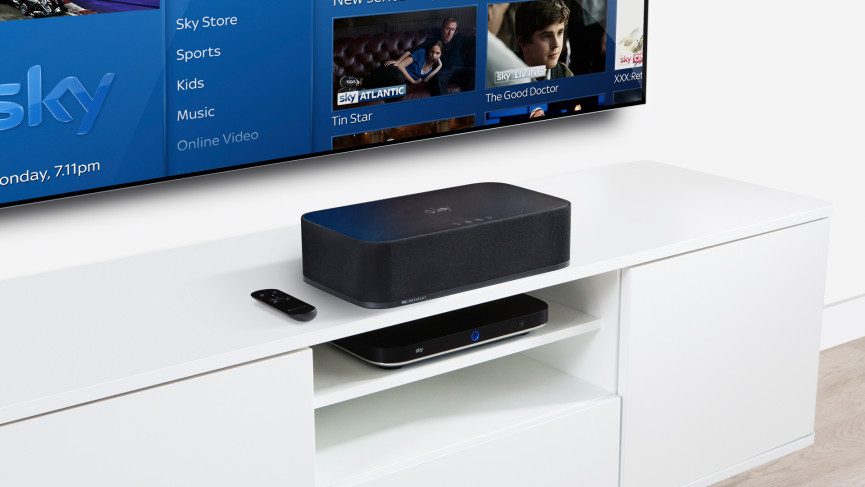
One of the traits we look for with stereo music playback is clean, crisp separation. Just how easy is it to hear individual musical instruments? Are the vocals understandable? Here both the KEF LSX and Bluesound player shine. Because they’re conventional stereo speakers, the KEF LSX offer supreme separation and musicality. If music playback is just as important as TV audio, these are your best bet.
Similarly, Bluesound Pulse Mini 2i proves particularly good at providing room-filling audio, and its bass has a real kick.
Best soundbar reviews: The test results
With its innovative Dolby Atmos effect, and a great all-round performance with regular TV and two-channel music, the £599 Sony HT-ZF9 is our best buy.
We love the look of this soundbar. The design is part gloss, part matte and features a removable magnetic grille. One metre wide, it’s easily partnered with larger screen sizes.
The matching subwoofer is relatively compact, but uses a forward-facing speaker driver. So when it moves air you can really feel it. The sub can hit low notes, but it’s particularly smooth with mid-bass. The Fast and the Furious 7 sounds fabulous – those engines really pur!

Unusually for a Dolby Atmos soundbar, it has only a forward-facing driver array. Given that Atmos soundtracks are often distinguished by their use of height, you might expect some ceiling-facing speakers in the mix. But Atmos cinema-style sound is delivered using a Vertical Sound Engine, a clever Sony processing trick that fools your ears into thinking the audio is coming from above.
The Samsung HW-N850 is in many ways equally as impressive, but is considerably more expensive at £999. Unlike the Sony, it features an array of drivers to the front and sides, plus additional upfiring speakers.
If you’re looking for something a little more discrete, and affordable, the Q Acoustics M2 is our favourite soundbase. At just £299 it’s a stone cold bargain.
Behind its non-removable grille are a pair of front-facing drivers featuring something called BMR (Balanced Mode Radiator). One lovely characteristic of BMR speaker technology is its wide spread of sound, so there’s no sweet spot. You’ll hear great audio wherever you sit. In addition to this array, there’s a down-firing 3-inch subwoofer.
The M2 delivers ballsy performance, and while there’s no attempt at surround sound – it’s unapologetically stereophonic – if you’re after no-frills sonic excitement you’ve come to the right place.
The Sonos Playbase can be considered a posh alternative to the Q Acoustics model. Also a soundbase plinth design, it’s more refined musically, but still manages to excite when it comes to the blockbusters.

That opening sequence from Mad Max: Fury Road is appropriately energetic. You’ll want to duck as the War Boy racers roar into shot!
Priced at £299 if you’re a Sky TV subscriber, the Soundbox is an unusual block-like shape, so sitting one around the TV could be awkward. But the design incorporates a wide array of speakers, with no subwoofer required.
Behind the wraparound fabric grille are six woofers and three full-range drivers – one facing forward, the other two at the back. The Soundbox uses wall reflections to create a three dimensional, enveloping soundstage. One consequence of this is that you can’t hide it away in a cabinet. Sky doesn’t reveal amplification, but it’s certainly not short of welly.
For sheer brute force, the Teufel Cinebar Pro isn’t easily beaten. It’s powerful, with 200W going to the main bar, and an additional 150W driving the subwoofer.
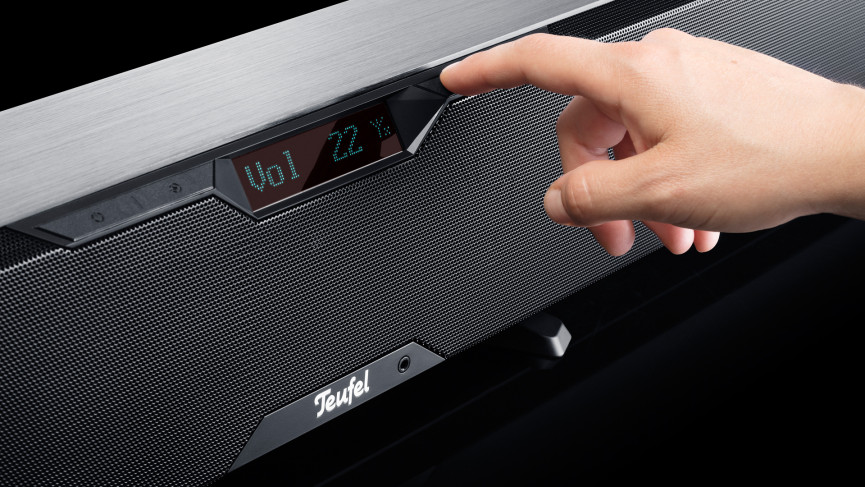
You’ll need a big room, or at least a big cabinet, to accommodate this beast. Fine if you’ve wall-mounted your TV, more of a challenge if you haven't. The set-up is also the most convoluted of the group. For optimum results you need to manually enter the distance from soundbar to seating position, and also the side walls. It’s a bit of a faff, but the end result sounds great.
Rounding out our top ten are the Hitachi AXS460BTU and Polk Command Bar. The latter has its cute integrated Amazon Alexa, but lacks the sonic refinement exhibited by the others we tested. The Hitachi gets relegated to last position because it just doesn’t have the power or presence to consistently entertain.
The best soundbar reviewed
Sony HT-ZF9, £599
The Sony HT-FZ9 soundbar subwoofer combo is as good with music as it is with movies, and while it doesn’t have upfiring Dolby Atmos drivers to create audio effects that reach high above your head, it uses advanced signal processing to achieve much the same result.
For example, during Okja (Netflix), when the Animal Liberation Front liberate the titular super pig in the underground tunnel, there’s a splendid sense of echo and reverb that extends well beyond the confines of the soundbar.

There’s a lot of technology on board, but you don’t have to get too involved. Sony’s Vertical Sound Engine kicks in automatically when it senses an Atmos signal from Blu-ray or a set-top box. The HT-ZF9 has no problem with complex movie action, and regardless of any onscreen chaos, details are kept crisp, clean and easy to follow.
There’s also a separate upmixer for two-channel and conventional surround sound 5.1 mixes, called Vertical S. Pretty much everything you listen to sounds colossal. Indeed, one of the HT-ZF9’s big attractions is that it’s exciting with almost any source.
Connections include two HDMI inputs, plus a HDMI out with ARC, and each can handle a 4k signal. There’s also an analogue stereo 3.5mm minijack input, USB port, and optical digital audio input.
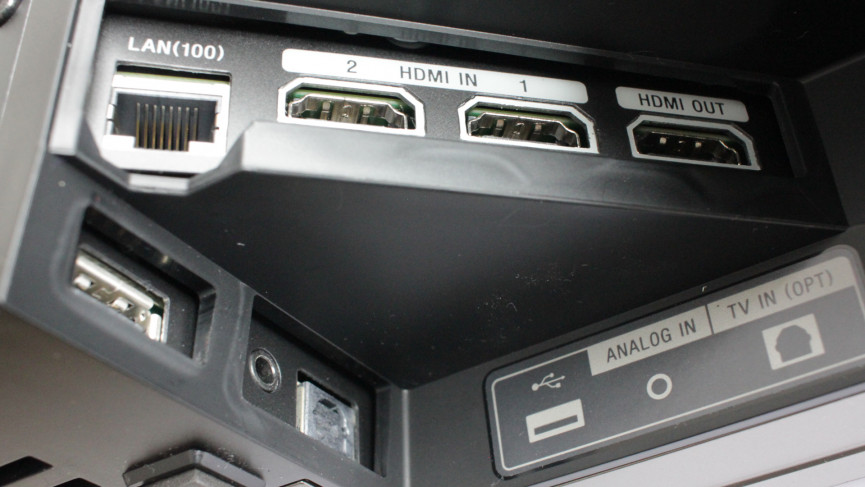
Wireless connectivity covers Wi-Fi and Bluetooth, and there’s Chromecast with Google Assistant built in. You can even partner Bluetooth headphones for late-night movie or gaming sessions.
It’s certainly worth noting that the HT-ZF9 can also be upgraded, with a pair of wireless rear speakers, the optional SA-Z9R. This will create a physical 5.1 system. For this test, we stuck with the original soundbar and sub combo though.

The system is compatible with a range of High Res Audio sources, including DSD and 192kHz 24bit FLAC, which means you can enjoy the highest quality audio recordings available. Lower-resolution MP3 tracks are also upscaled, which helps improve the quality, but if you’re still listening to MP3s – stop being so Noughties!
That wireless subwoofer detonates with considerable power. Sony quotes an overall system output of 400W, which in layman’s terms means it’s more than loud enough to startle the cat.
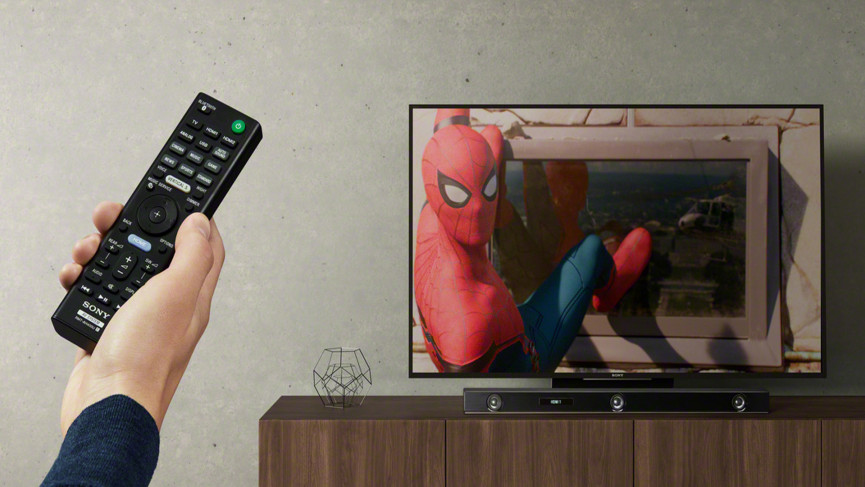
If the HT-ZF9 does have a flaw, it’s that it can be a bit confusing. There’s something called Dolby Speaker Virtualiser, in the menu, which is a Dolby technology. This switches off Sony’s own Vertical Sound Engine, but doesn’t sound as good with music. Our advice is to just ignore this option.
But, when it comes to overall performance, versatility with movies and music, and sheer value for money, this Sony system stands head and shoulders above the competition.
The best soundbar for value reviewed
Q Acoustics M2, £299
Our best value soundbar isn’t actually a soundbar at all – it’s a soundbase. The end result is the same, though, as the Q Acoustics M2 just goes about things differently. The cabinet is robust enough to take a large screen TV, but it can be positioned on a shelf below the screen if you prefer.
All the BMR (Balanced Mode Radiator) drivers face forward and to optimize positioning there’s a three-way equaliser, with one setting for on-furniture placement, plus two in-cabinet modes. Whatever way you set it, its sonic delivery remains smooth.
Connections comprise a single HDMI with ARC, plus an optical digital audio input and analogue stereo phonos. There’s also a 3.5mm minijack.
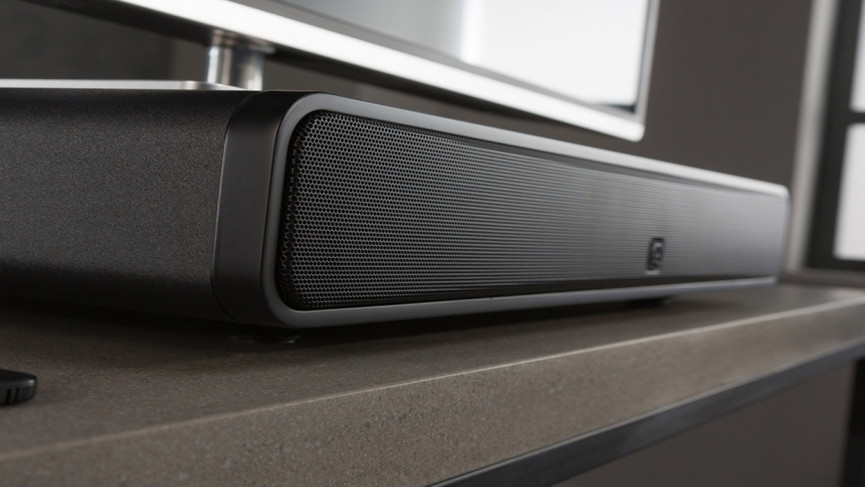
We suspect one of the reasons why the M2 is so cheap is that there’s no network connectivity, but Bluetooth streaming with aptX is supported, and there’s even NFC for simplified pairing. If you need online connectivity you can always add a Chromecast Audio device via the minijack input.
The integrated down-firing subwoofer means you don’t need a separate bass box. One benefit of this approach is tidiness – there’s one less component to fit in your room. The system doesn’t offer the deep bass response that it might with a separate subwoofer, but we can happily live with the compromise – particularly in a flat or apartment. If you want to max out the bass, look for the MoviEQ mode.
The M2 has a power output realistically rated at 80W (2 x 20W for the stereo pair, with 40W going to the sub). It doesn’t go as loud as the Sony HT-ZF9 (which is rated at 400W), but it’s worth noting that quoted power specifications from different brands are never directly comparable. The bottom line is that this Q Acoustics soundbase has more than enough poke to keeps things lively.
Comparing the rest on test
Our left-field addition to this group of TV sound systems, the KEF LSX, is a formidable Hi-Fi proposition that’s the best looking, and comes in a choice of five unique colours.
Key to its musicality is KEF’s own Uni-Q driver, which keeps the audio tight and rhythmical. The speakers use four Class-D amplifiers, one for each drive unit. Power output is rated at 2 x 30W and 2 x 70W. If you want to add a subwoofer, for a 2.1 configuration, there’s an output to support that option.
In addition to Wi-Fi connectivity there’s Bluetooth aptX and AirPlay 2 compatibility. Connectivity includes an optical digital input and a 3.5mm aux input.
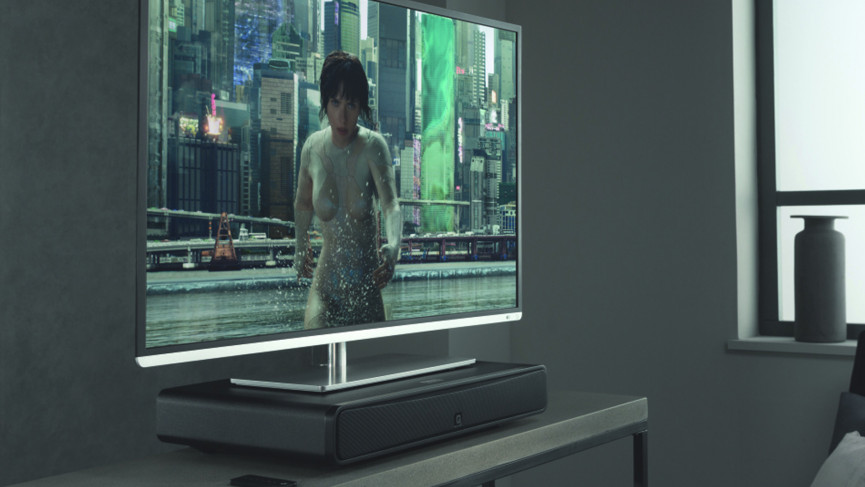
You wouldn’t consider the Soundbox if you weren’t already a Sky customer (and if you are, you perhaps should), but its low cost and unique functionality make it a fascinating proposition and we love how clever it is. Adaptive EQ based on Sky content works really well for sports and dialogue is consistently fine, too. We’d probably give it a pass when it comes to home cinema, though, as it’s just not dynamic enough.
The Playbase is by Sonos and therefore works seamlessly with other Sonos multiroom speakers. That’s all you really need to know. You can add the Sonos subwoofer to the Playbase, but in truth we didn’t feel it necessary. It already packs plenty of welly. Probably not the place to start a Sonos home audio system, but it could provide the finishing touch.
Big and beautifully built, the German-made Teufel offers a blockbuster performance with movies and cinematic TV shows. The supplied subwoofer is the most effective in our group, so it’ll really put the rock into Bohemian Rhapsody.

The Bluesound Pulse Mini 2i makes a big noise despite its small cabinet. Doing all the work are a pair of 102mm woofers and 19mm tweeters, driven by 100W of amplification. In addition to Wi-Fi and Bluetooth, AirPlay 2 allows users to stream from their iPhone, iPad or Mac and, unlike Sonos, it supports Hi-Res Audio.
The Pulse Mini 2i also offers two-way Bluetooth. Using its Receive and Transmit functionality you can pair the player with wireless headphones, handy for those late night gaming sessions. The Polk Command Bar is probably best thought of an Echo Dot with the form factor of a soundbar, because that’s exactly what it’s like to use. Cranked up though it just stomps around in size 12 boots. Great if you want volume, but it’s not much fun to listen to.

Any soundbars to avoid?
If you want to give your TV a significant upgrade, this cheapie Hitachi AXS460BTU just doesn’t cut the mustard. Sure it looks good, the bar is ultra-slim and nicely finished in brushed aluminium and specification is strong, but it’s seriously underpowered.
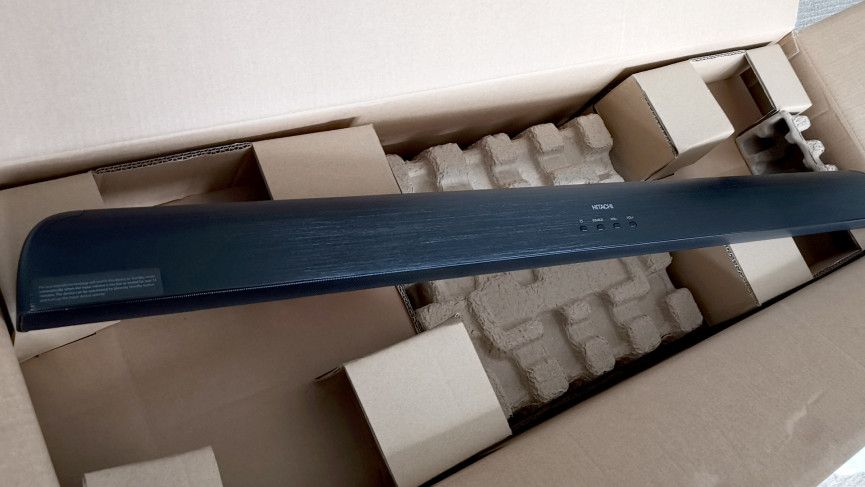
Hitachi optimistically quotes a peak output power of 460W, but concedes there’s just 2 x 25W going to the soundbar and 65W to the wireless subwoofer. The power shortfall to the latter proves calamitous, as it robs the subwoofer of snap and dynamic attack. Even a double bill of Godzilla and Fast and the Furious movies didn’t encourage the subwoofer to excite. A good sub should thump you in the chest, but this compact offering, with its 6-inch driver, has no power behind its punch.


